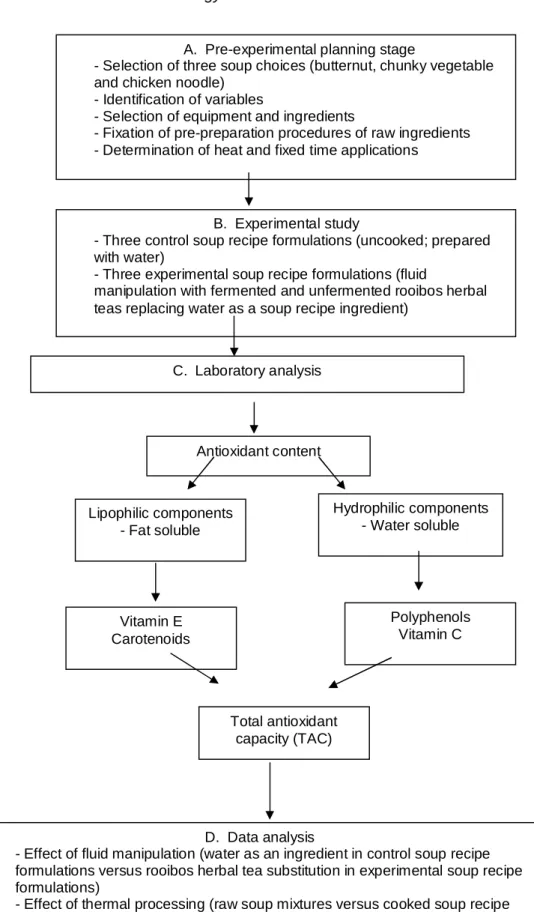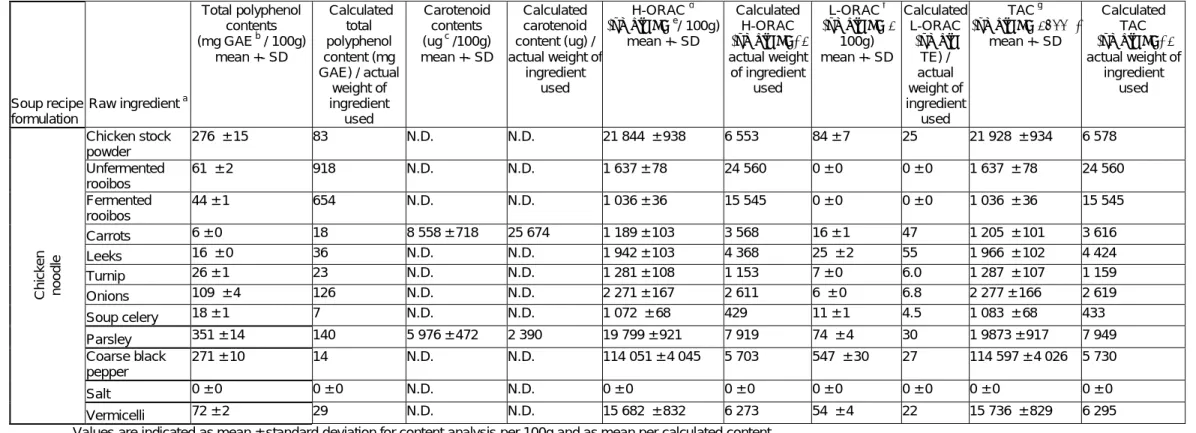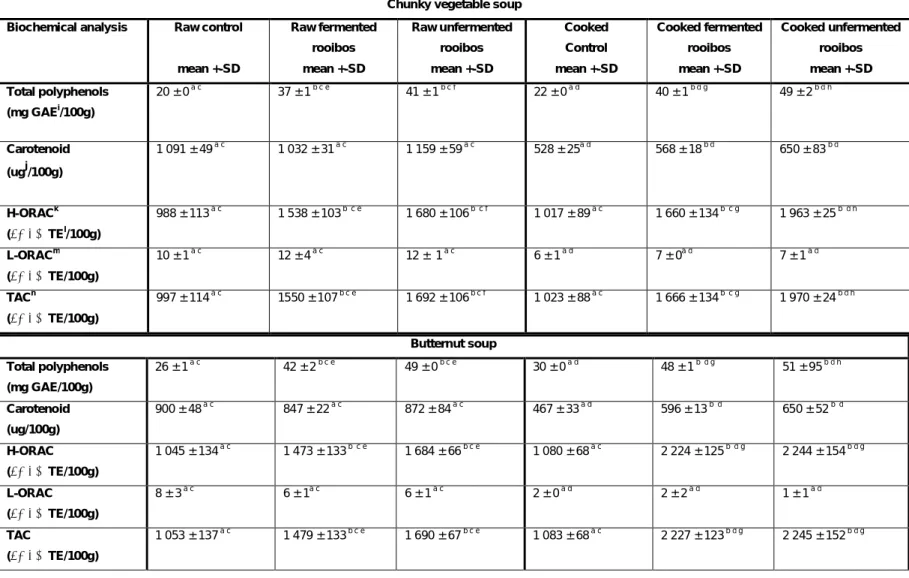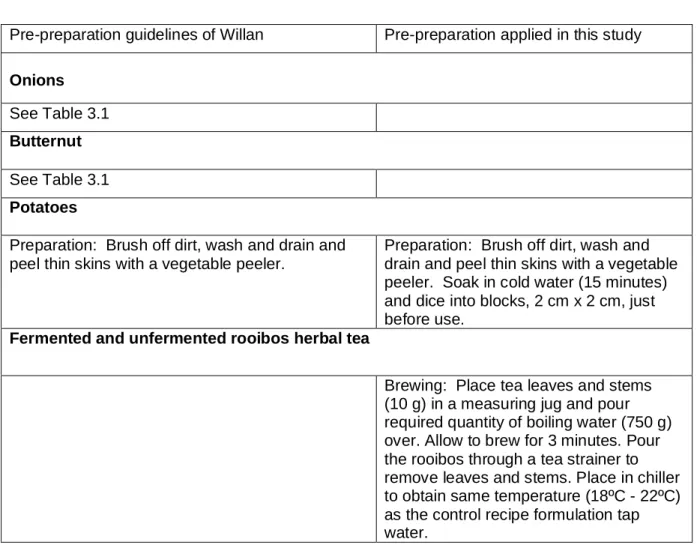The water in each of the soup recipe formulations (control) was replaced with fermented and unfermented/"green" rooibos (experimental recipe formulations). Thermal processing also significantly increased (p < 0.05 for each) H-ORAC and TAC of experimental cooked butter soup formulations containing fermented and unfermented rooibos.
INTRODUCTION
Using an experimental study design, three popular soup recipe formulations were selected from South African cookbooks and standardized. Water in the three control recipe formulations was replaced with fermented and unfermented rooibos, respectively.
LITERATURE STUDY
Oxidative stress
An excess production of ROS (resulting from either mitochondrial electron transport chain reactions or excessive stimulation of NAD(P)H) leads to oxidative stress (Serafini & Del Rio Valko et al which, as indicated above, is a harmful process. The targeting of Oxidative damage varies depending on the characteristic of the cell, the type and the amount of stress imposed (Willcox et al.
Oxidative stress in chronic disease development
- Cardiovascular disease
- Cancer
- Human Immunodeficiency Virus
These transformed macrophages are considered precursors to the development of the occlusive plaque of atherosclerosis (Willcox et al. Several mechanisms contribute to the nature, rate, and extent of weight loss (Pace & Leaf, 1995:524).
Natural foods versus dietary supplements as dietary antioxidant sources
Whole grains consist of the endosperm, germ and bran of the grain. According to the 5-A-Day program, one of five or more daily servings of fruits and vegetables can be one serving of fruit juice (Popkin et al.
Consumption of natural antioxidant sources by South Africans
A 24-hour dietary recall study reported by Vorster and Nell (2001:S19) determined the average daily carbohydrate intake, among other nutrients, of adult South Africans aged 25 to 65 years. Food consumption results were summarized to determine the average intake of food and drink commonly consumed by South Africans.
Exogenous food antioxidants and disease prevention
- Non-nutrient antioxidants
- Flavonoids
- Carotenoids
- Nutrient antioxidants
- Vitamin C
- Vitamin E
For example, approximately 90% of quercetin is localized in the first and second layers of the onion (Ewald, Fjelkner-Modig, Johansson, Sjoholm & Akesson, 1999:231). In the leaves of the higher plants, vitamin E occurs mainly as α-tocopherol, which is found in the chloroplasts.
Other ways to incorporate antioxidants into the diet
Platelets treated with tocopherol showed a significant reduction in platelet aggregation induced by arachidonic acid, phorbol ester, or adenosine 5-diphosphate, and as such would be independent of the antioxidant properties of vitamin E. Fortification is used for the following purposes: to help ensure that the population's daily intake of vitamins and minerals corresponds to the required nutrient intakes (RNIs) when intakes from non-fortified foods do not reach recommended levels and provides levels of vitamins, minerals and trace elements higher than the current RNIs if a benefit against disease manifestation in healthy persons or in the progression of an already existing disease in affected persons (Serra-Majem, 2001:104). Nutrients must be bioavailable and sufficiently stable under normal conditions of storage and use.
Consumption of foods containing added nutrients should also not create a nutritional imbalance and ensure that an excessive intake of nutrients will not occur, given the collective amounts from other sources in the diet. Four categories of foods can be identified where the addition of vitamins and minerals is mandatory in some countries: (a) foods for special dietary uses; (b) foods that have lost nutrients during production; (c) food resembling ordinary food; and (d) staple foods that represent ideal vehicles for nutrients (Richardson, 1990:40).
Effect of processing on antioxidants in food
- Flavonoids
- Carotenoids
- Vitamin C
- Vitamin E
When comparing the effect of the three cooking methods, steaming resulted in the highest phenol content, followed by boiling and microwaving resulting in the lowest phenol content. An overall loss of 25% in quercetin glucosides in onions after frying and cooking has also been reported. Onion samples cooked in the microwave had lower losses of flavonoids than the samples cooked in water.
The kaempferol loss was again greatest in the samples that had been kept warm (Ewald et al. This may be due to the location of the carotenoids in the plant tissue (Gayathri et al., 2004:35).
Total antioxidant capacity
In the Maillard reaction, the resulting high antioxidant capacity is generally attributed to the formation of brown melanoidins (Manzocco, Calligaris, Mastrocola, Nicola & Lerici, 2001:340). The antioxidant capacity is a measure of the moles of a given free radical removed by a test solution, independent of the antioxidant activity of any antioxidant present in the mixture (Ghiselli, Serafini, Natella & Scaccini. The antioxidant capacity of plant foods is derived from the combined synergistic action of a wide range of antioxidants such as vitamin C and vitamin E, polyphenols, carotenoids, terpenoids, Maillard compounds and trace minerals (Perez-Jimenez, Arranz, Tabernero, Diaz-Rubio, Serrano, Goni & Saura-Calixto , 2008:275).
Antioxidant capacity is usually measured in food samples obtained with chemical aqueous solvents (methanol, ethanol, acetone, etc.). Some antioxidants in fruits and vegetables undergo certain reactions after harvesting that can cause a decrease in the antioxidant capacity of the sample.
Study approach
The antioxidant content of plant foods, and hence the associated antioxidant capacity, depends on the variety and degree of ripening. Another method of incorporating additional antioxidants into the diet of the South African population is recipe manipulation by incorporating antioxidant-rich ingredients into recipe formulations to increase the recipe's TAC and resulting antioxidant intake via such prepared food consumption. Recipe manipulation as a method to increase the TAC of South African dietary intake formed the research approach of this study.
The study considered the inclusion of rooibos as the antioxidant-rich source, due to its polyphenol content, in soup recipe formulations as a food carrier. Thermal processing could have a major impact on the resulting TAC of the recipe manipulation of the soup, which could override the presumed probable increase in the recipe formulation TAC due to the antioxidant supply provided by the inclusion of rooibos as a recipe ingredient.
METHODOLOGY
- Type of study and study design
- Selection of the recipe formulation ingredients and equipment
- Fixation of pre-preparation procedures of raw ingredients
- Determination of soup recipe formulation heat applications and fixed time allocations for recipe formulation standardisation
- Food samples, sampling and extraction procedure for analysis
- Total antioxidant capacity and antioxidant content analysis
- Statistical analysis
The main variable identified in the preparation of soup recipe formulations that can affect TAC (dependent variable) and must be controlled, is the application of heat. The standardized base recipe formulations formed the control recipe formulations for each of the selected soup recipe formulations. The unit of expression of TAC is μmole (µ) Trolox equivalents (TE) per 100 g fresh weight (FW).
It was therefore assumed that H-ORAC would be mainly represented by the total polyphenol content of the soup recipe formulations. Only the carotenoid content of the recipe formulations was determined as an indicator of the lipophilic component in the soup recipe formulations.

RESULTS
Total polyphenol, carotenoid and TAC contributions of the ingredients to the raw soup recipe formulations
The amounts of rooibos leaves and stems used (2.5 g per 180 ml of water) were not included in the soup recipe formulations as the leaves of the rooibos herbal tea were drained before the liquid was added to the soup recipe formulations and therefore do not form part of the total weight of the soup recipe formulation. Each ingredient's contribution to the total polyphenol content of the different recipe formulations is shown in Table 4.2, expressed as mg GAE/relevant weight used in the formulations. The fermented and unfermented rooibos H-ORAC was higher than that of some of the vegetables, but not as high as that of the herbs, spices and seasonings.
The fermented and unfermented rooibos made no contribution to the L-ORAC of the raw recipe formulations. The TAC of the raw ingredients mainly consisted of the H-ORAC of the raw ingredients.

Effect of rooibos inclusion on the total polyphenol and carotenoid contents and the TAC of the raw and cooked soup recipe formulations
- Chunky vegetable soup
- Butternut soup
- Chicken noodle soup
Experimental crude soup recipe formulation (fermented rooibos vs. unfermented rooibos) contents for the soup recipe formulation indicated by different symbols (e and f) are significantly different (p < 0.05). Formulation of the experimental cooked soup recipe (fermented rooibos vs. unfermented rooibos) contents for the soup recipe formulation indicated by different symbols (g and h) are significantly different (p < 0.05). The increase was higher with unfermented rooibos substitution (+ 183 ug/100 g) compared to fermented rooibos substitution (+ 129 ug/100 g) in the cooked soup recipe formulations.
In the cooked soup recipe formulation, the inclusion of fermented or unfermented rooibos also significantly increased TAC (p < 0.05 for each). However, there was no significant (p > 0.05) difference in TAC for the two cooked experimental soup recipe formulations.

Effect of thermal processing on the total polyphenol and carotenoid contents and the TAC of the soup recipe formulations
- Chunky vegetable soup
- Butternut soup
- Chicken noodle soup
The decrease in carotenoid content was greatest in the heat treatment of the raw control soup formulation (- 563 µg/100 g), followed by the unfermented rooibos experimental soup formulation (- 509 µg/100 g) and with the smallest decline. occurring in the raw fermented recipe of the experimental rooibos broth (- 465 µg/100 g). Heat treatment significantly reduced the L-ORAC of the cooked control and experimental formulations of the fragile vegetable soup recipes compared to the raw control and experimental recipe formulations. Heat treatment increased the TAC of the control and experimental formulations of the fragile vegetable soup recipes.
Heat treatment significantly (p <0.05) increased the total polyphenol content of the cooked control formulation of the chicken noodle soup recipe compared to the raw soup mixture. Heat treatment significantly (p < 0.05 for each) decreased L-ORAC of the cooked control and both experimental chicken noodle soup recipe formulations compared to the raw control and experimental recipe formulations.
DISCUSSION
- Raw ingredient total polyphenol content and TAC
- Effect of rooibos inclusion on the TAC of the soup recipe formulations
- Effect of thermal processing on the total polyphenol content, H-ORAC and the TAC of the soup recipe formulations
- Limitations and strengths of the study
The total polyphenol content of four vegetables used in soup recipes is published in the USDA database. Spinach was not a vegetable ingredient used in the soup recipe formulations of the current study. The total polyphenol content and composition of unfermented (green) rooibos differs from that of fermented (traditional) rooibos.
Thermal processing caused a reduction in the TAC of the experimental chicken noodle soup recipe formulations compared to the experimental raw chicken noodle soup recipe formulations. The effect of thermal processing on the TAC of the soup recipe formulations has not been fully investigated (for example, vitamin E and vitamin C contents and bound versus free phenols were not determined).
CONCLUSIONS
Thermal processing caused a significant decrease in L-ORAC of all control and experimental soup recipe formulations. The content of carotenoids in all control formulations and experimental soup recipes decreased significantly after thermal processing. Thermal processing caused a significant increase in the TAC of the experimental vegetable soup recipe formulation.
The TAC of both the raw experimental butternut soup recipe formulations increased significantly upon thermal processing. The H-ORAC of the experimental chicken noodle soup recipe formulations on thermal processing was significantly lower than that of the raw soup mixes.
RECOMMENDATIONS
Thermal processing also caused an increase in the TAC of the experimental formulations of the thick and buttery vegetable soup recipe compared to the experimental formulations of the thick and buttery vegetable soup recipe. Oxidative stress in atherogenesis and arterial thrombosis: the disconnect between cellular studies and clinical outcomes. Flavonoids and other plant phenolics in the diet: their importance as antioxidants, Journal of Nutritional and Environmental Medicine, 12: 39-51.
Total antioxidant capacity - a novel early biochemical marker of oxidative stress in HIV-infected individuals. Synergy research: vitamins and secondary plant components in the maintenance of the redox homeostasis and in cell signaling. Place the remaining ingredients in the pot and let it soak for a few hours before cooking.
Turn the stove temperature to 6, place the pot on the stove and put all the ingredients in the pot except the parsley, water and spices.



